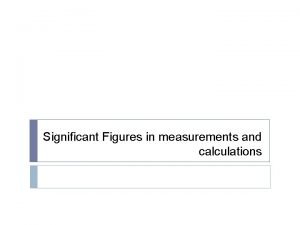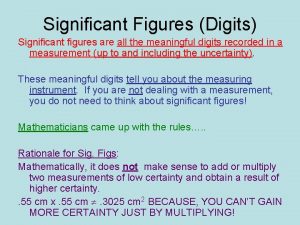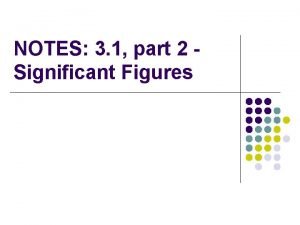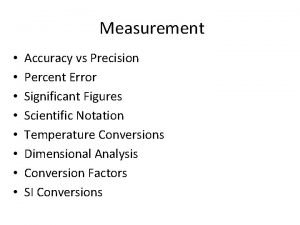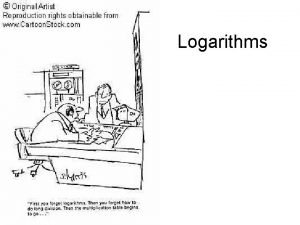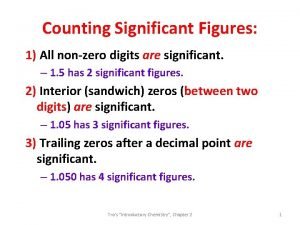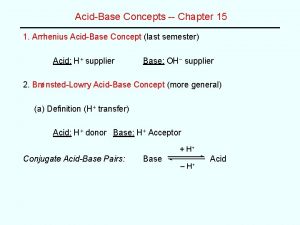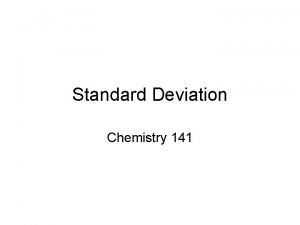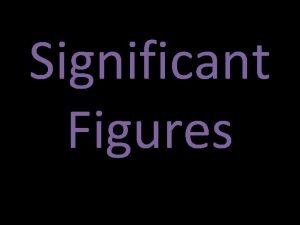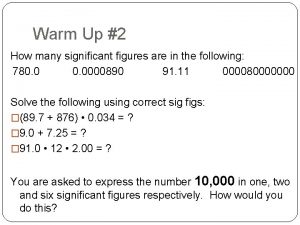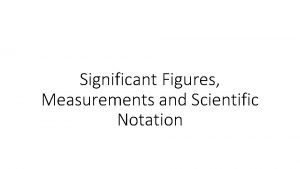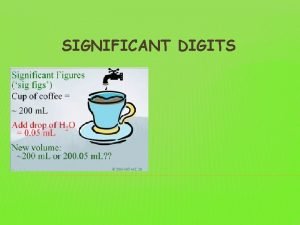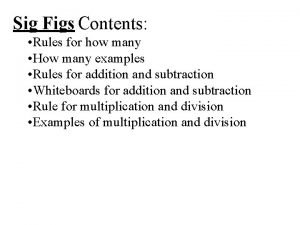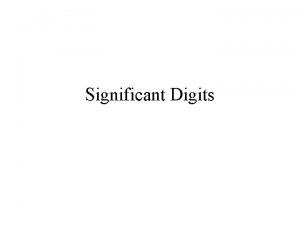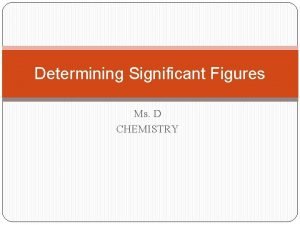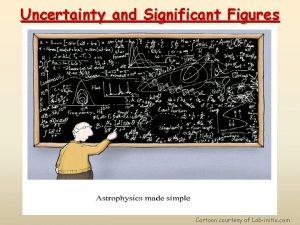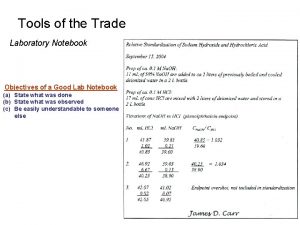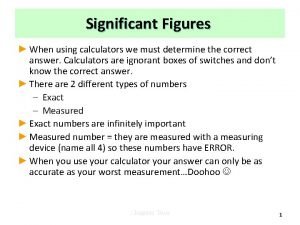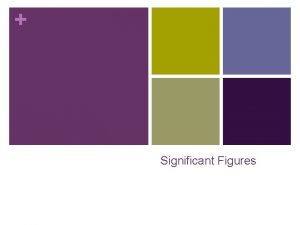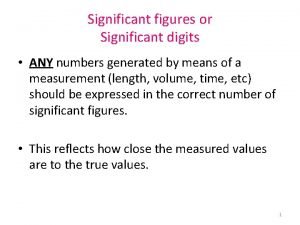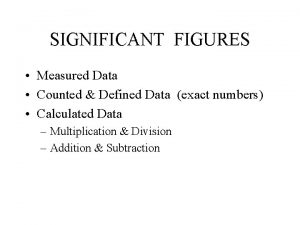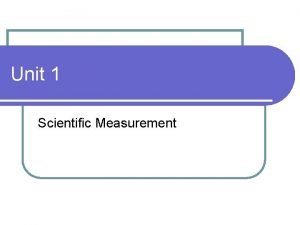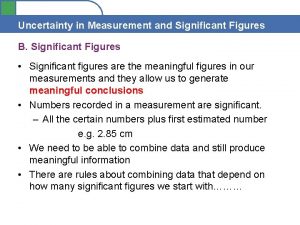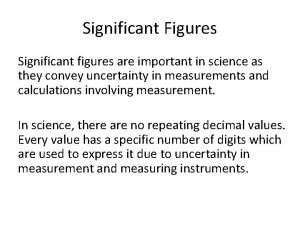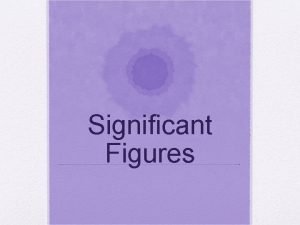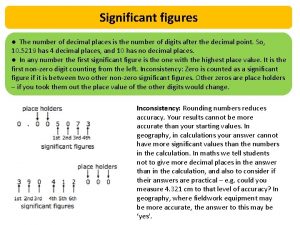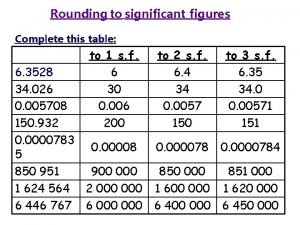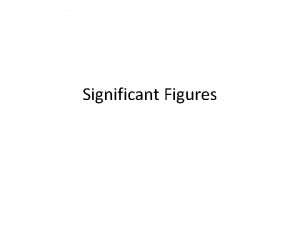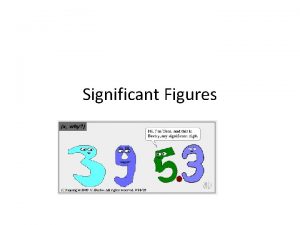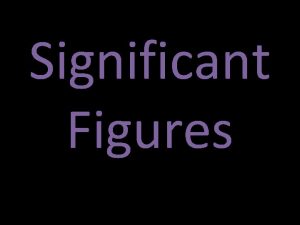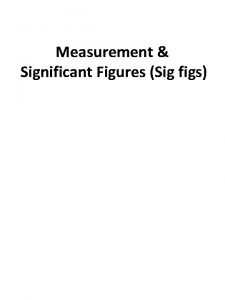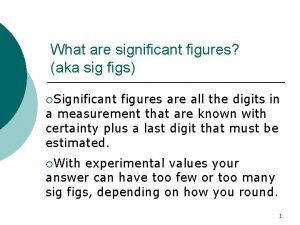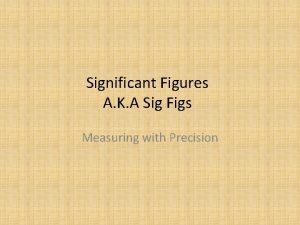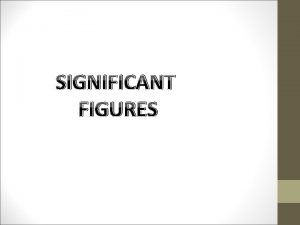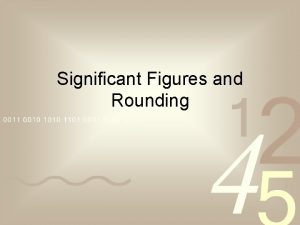Significant Figures sig figs Measuring volume SigFig Rules



























































- Slides: 59

Significant Figures (sig figs)

Measuring volume



Sig-Fig Rules For measured values…all certain digits +1 estimated digit. 1. All non-zero digits are significant Example: 2. 4 (2 sig figs) 2. Leading zeros are NEVER significant Example: 0. 01 (1 sig fig) 3. In between zeros are always significant Example: 2. 017 (4 sig figs) 4. Trailing zeros are significant if there is a decimal point in the number Example: 0. 00200200 (6 sig figs)

Extra Rules/tips In scientific notation, only count the digits in the coefficient

Exact Numbers Exact numbers, such as the number of people in a room, have an infinite number of significant figures. Another example of this are defined numbers, such as 1 foot = 12 inches. There are exactly 12 inches in one foot. Therefore, if a number is exact, it DOES NOT affect the accuracy of a calculation nor the precision of the expression.

Practice 0. 00100 m 2. 08 x 102 L 480 cars 6, 280 feet 9000 inches 9000. inches 1 quart = 0. 946 L

Addition and subtraction Answer is rounded to the least amount of decimal places Example: 5. 02 - 3. 486 +5. 1 =

Rounding If the digit is less than 5, round down. If the digit is equal or greater than 5, round up

Multiplication and Division Final answer sig figs depends on the value with lowest number of sig figs in the problem. Example: 6. 56 x 2. 3 Number of sig figs? Answer =______

Conclusion Why can you not simply put the answer your calculator gives you when adding and subtracting? When adding and subtracting, what are you basing your answer on so your answer reflects the precision of your measurements? When multiplying and dividing, what are you basing your answer on so your answer reflects the precision of your measurements?

Review I have 425 grams of fruit loops. If 15 fruit loops is 3. 0 grams, how many fruit loops do I have?

Extended Practice Problem An empty graduated cylinder has a mass of 15. 31 g. When 8. 357 m. L of an unknown liquid is placed in the graduated cylinder, the combined mass is found to be 24. 86 g. What is the density of the liquid?

PERIODIC TABLES!!!!

HOMEWORK! Sig figs practice problems.

The Mole…. . What do the substances on the front table have in common?

BREAKING BAD $43, 860, 000.

Essential Question: How many atoms are in “that”? Notice “that in quotation marks” What does this mean?

THE MOLE…. . Atoms are very small. In order to quantify them, we need a lot, 6. 02 x 1023 to be exact 6. 02 x 1023 of anything per mole Example. 1 mole of paperclips= 6. 02 x 1023 paperclips How many baseballs are in 1 mole of baseballs?

THE MOLE…. . The periodic table gives us mass in grams per mole, which means the mass of 6. 02 x 1023 atoms each element Moles are used as a conversion factor (think…. g/mol)

Finding molecular weights of compounds Write out each element in the compound. Supply the molecular weight for each compound, as given on the periodic table Multiply each molecular weight by the subscript as given in the compound. Add them up. Ex. H 3 PO 4 H= P= O= =

Carbon

Potassium

Lithium

Beryllium

Magnesium

Manganese

Manganese

Fluorine

P

Na

P

Si

Sn

Bi

Au

Sb

U

Copper

Zinc

Iron

Titanium

Neon

Ca

S

I

Ar

Mercury

Silver

Review If I have one mole of beef jerky sticks, how many beef jerky sticks do I have?

MOLE HIGHWAY! Volume MASS MOLECULES https: //www. youtube. com/watch? v=Kg-za. G 0 ck. Vg

DO NOW! What is the molar mass of Ag. Cl? If I have 4. 0 grams of Ag. Cl, how many moles do I have? How many molecules of Ag. Cl do I have? If I have 4. 0 grams of Ag. Cl, how many molecules do I have?

Essential Question! How “strong” is that solution? Looking at the three solutions on the front table, what is the difference between the three?

Essential Question! How “strong” is that solution? Looking at the three solutions on the front table, what is the difference between the three? Think about concentrated vs. dilute

Concentrated vs. Dilute With a partner, come up with a definition of the following terms. Concentrated: Dilute:

What you will be doing…. . Differentiate between different methods of describing the concentration of a solution. Given two of three characteristics of volume, molarity, and solute mass, calculate third. Prepare a solution of given concentration. Calculate the effects of colligative properties of a solution.

Molarity How we define the concentration of a solution Use the equation: Molarity (M) = mol solute/liters of solution Review: What is the solute? What is the solvent? Let’s Practice. Get out your workbooks and turn to Guided Practice: Molarity of Solutions

MOLE HIGHWAY! Volume MASS MOLECULES
 Rules for significant figures
Rules for significant figures Significant figures rules addition
Significant figures rules addition Sig fig rules for antilog
Sig fig rules for antilog Sig figs rules
Sig figs rules Significant number
Significant number Sig fig ca
Sig fig ca Logarithm in chemistry
Logarithm in chemistry Buret sig figs
Buret sig figs Ruler significant figures
Ruler significant figures Significant figures chemistry
Significant figures chemistry How to round sig figs when multiplying
How to round sig figs when multiplying Sig figs with decimals
Sig figs with decimals Reduction oxidation
Reduction oxidation Significant figures examples
Significant figures examples How many sig figs for percent error
How many sig figs for percent error Log a x log a
Log a x log a Chemistry sig figs
Chemistry sig figs Hfacid or base
Hfacid or base Precision standard deviation
Precision standard deviation How do significant figures work
How do significant figures work Significant figure game
Significant figure game How many sig figs in 320
How many sig figs in 320 Significant figures of 956
Significant figures of 956 Caressig
Caressig How many sig figs in 7080
How many sig figs in 7080 87 pg in scientific notation
87 pg in scientific notation How many sig figs are in .000077?
How many sig figs are in .000077? Significant figures rules with examples
Significant figures rules with examples How many sig figs in 1250
How many sig figs in 1250 How many sig figs are in 5000
How many sig figs are in 5000 Where do sig figs come from
Where do sig figs come from How to count sig figs in scientific notation
How to count sig figs in scientific notation When to use sig figs in chemistry
When to use sig figs in chemistry How to count significant digits
How to count significant digits Sig figs division
Sig figs division How to tell significant figures
How to tell significant figures How do sig figs work
How do sig figs work Number rule
Number rule Stoichiometry sig figs
Stoichiometry sig figs Sig figs pacific atlantic rule
Sig figs pacific atlantic rule Significant figures definition
Significant figures definition Rules of significant figures
Rules of significant figures Significant figures rules
Significant figures rules Significant figures rules
Significant figures rules Significant figures rules
Significant figures rules Why significant figures are important
Why significant figures are important Whats a sigfig
Whats a sigfig Is ap chemistry hard
Is ap chemistry hard How many uncertain digits are in a measurement
How many uncertain digits are in a measurement What does significant figures mean in math
What does significant figures mean in math Significant numbers
Significant numbers What are significant digits in math
What are significant digits in math Significant figures definition
Significant figures definition 3 significant figures examples with answers
3 significant figures examples with answers 3 significant figures examples with answers
3 significant figures examples with answers Significant figures purpose
Significant figures purpose Significant figures for ph
Significant figures for ph What is 2 significant figures
What is 2 significant figures Round off to 2 significant figures
Round off to 2 significant figures Rounding upper and lower bounds
Rounding upper and lower bounds








